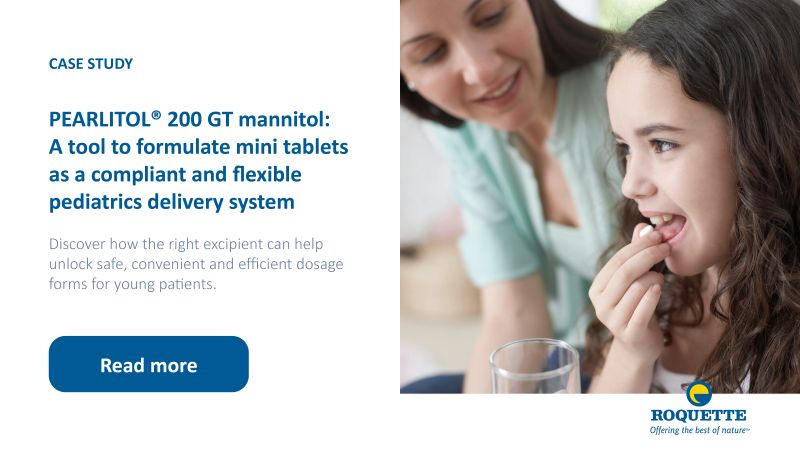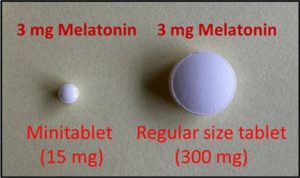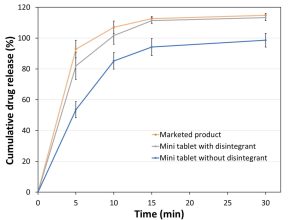Case Study PEARLITOL® 200 GT Mannitol: A Tool to Formulate Mini Tablets as a Compliant and Flexible Pediatrics Delivery System

PURPOSE
Mini tablets are a multiple unit dosage form with a size of less than 3.0 mm in diameter with great flexibility to deliver appropriate doses to the pediatric age group. They can be given in different numbers, according to dosage requirements, with no special prerequisite of formulating age group customized dosage tablets. Mini tablets are a friendly drug delivery system for patients having impaired swallowing issues with a polypharmacy therapy. The objective of the study was to develop melatonin (as a model drug) mini tablets, by direct compression, for pediatrics to replace conventional size tablets at the same strength of dose.
MATERIALS AND METHODS
Materials
Melatonin (BOC Science) as model drug.
PEARLITOL® 200 GT mannitol (Roquette) as direct compression filler-binder.
GLYCOLYS® sodium starch glycolate (Roquette) as disintegrant.
Vegetal magnesium stearate (Roquette Magnesium Stearate) as lubricant.
Methods
Blending
Mini tablets of 3 mg melatonin were formulated according to table 1.
Table 1. Formulations of 3 mg melatonin mini tablets
| Ingredients | Formulation composition with disintegrant (%) | Formulation composition without disintegrant (%) |
|---|---|---|
| Melatonin | 20.00 | 20.00 |
| PEARLITOL® 200 GT | 75.39 | 78.53 |
| GLYCOLYS® | 3.14 | 0 |
| Magnesium stearate | 1.47 | 1.47 |
| Total | 100.00 | 100.00 |
Melatonin, PEARLITOL® 200 GT and possibly GLYCOLYS® were first blended in a TURBULA® mixer (WAB T2F) at 49 rpm for 5 min. The lubricant, magnesium stearate, was added to the blend and mixed at 49 rpm for 2 min. Approximately, 10 mg of sample blend was taken from three different spots for content uniformity evaluation.
Tableting
The powder mix was compressed using 2.5 mm standard concave punch (Natoli Engineering) single tip using STYL’One Evo compaction simulator (MEDELPHARM) simulating Korsch XL 400 tablet press. Formulation mix was compressed at four different compression forces (0.65 kN, 1.30 kN, 1.66 kN, and 2.10 kN) at 20 RPM (equivalent to a rotary press speed of about 42,000 tablets/hour) with a target mini tablet weight of 15 mg.
Tablets characterization
Breaking force was checked at each compression force using hardness tester. Disintegration of mini tablets was tested at 37°C in 800 mL of distilled water using Sotax DT50 disintegration tester. High performance liquid chromatography-ultraviolet (HPLC-UV) at a wavelength of 277 nm was used to quantify melatonin uniformity in powder blend and to evaluate its dissolution profile. Conventional marketed regular size melatonin tablet at same drug content (3 mg/tablet) were used as reference for dissolution comparison (see figure 1).

To reach within linearity range of HPLC method, three tablets are needed in each vessel. Dissolution of three tablets (9 mg melatonin) was done in each vessel (n=3) of 500 mL distilled water at 37 °C with a paddle speed of 100 rpm. Samples were taken at 5 min, 10 min, 15 min, and 30 min from each vessel and filtered using 0.20 µm nylon filter for melatonin quantification by HPLC.
RESULTS
The flowability of the blend was excellent, with a Hausner ratio of 1.11. The advantage of having excellent flow is indicated by the low weight variation of about 2% (10 mini tablets’ average weight was 15.4 ± 0.32 mg). Despite the small diameter die of 2.5 mm, mini tablets display weight consistency. The formulation blend displayed 99.5 % content uniformity, evaluated by HPLC, with a standard deviation of 0.45 %. In comparison, the weight variation of commercial melatonin tablets was higher (weight of three tablets from 902.91 mg to 934.28 mg).
Mini tablets formulated without disintegrant presented disintegration times of around 2-3 min at all compression forces. In addition, approximately 100 % melatonin was dissolved in 30 min (see figure 2) with more than 80% within 10 min.
Mini tablets formulated with disintegrant showed similar dissolution profile as the regular marketed control (see figure 2) with more than 80% drug released within 5 minutes.

Read the full Case Study here
Source: Roquette, website PEARLITOL® 200 GT Mannitol: A Tool to Formulate Mini Tablets as a Compliant and Flexible Pediatrics Delivery System (roquette.com)
Read more on “Disintegrants – Pharmaceutical Excipients” here:


